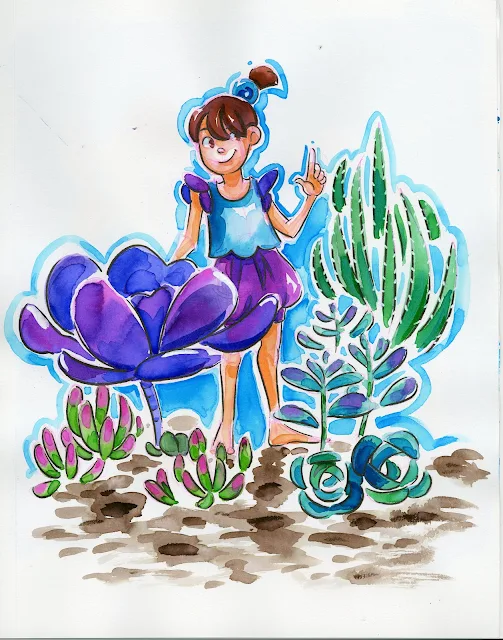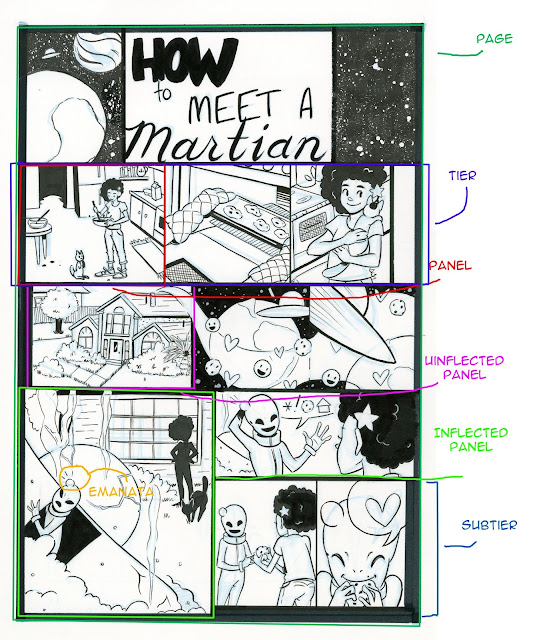The Case for Waterbased
 |
| Illustration created with Pentel Brushpens in Strathmore 400 Series FIeld Watercolor Sketchbook |
I've written a lot about alcohol markers over the years. I've reviewed dozens of brands, done numerous field tests, and for awhile, firmly proclaimed alcohol to be the king of markers. And while I still love Copic markers, Prismacolor markers, Shin Han, and Blick Studio Markers, my recent foray into writing about all things watercolor has given me a new appreciation for the right kind of waterbased marker.
Because the right marker, the right brush, can make all the difference.
 |
| Illustration created with Winsor and Newton watercolor markers |
Oh I get it, waterbased has gotten a bad rap, and I've contributed to that. And sure, when waterbased pretty much meant Crayola and other firm tipped markers with anemic inkflow, it's easy to see how alcohol markers, with soft foam rubber brushes and almost infinite blending capacity was the hands down winner.
But things change, artists and crafters innovate and experiment. And we end up with waterbased markers that turn the table on the old marker showdown.
Today I'm going to share a few of my favorite waterbased markers with you guys and explain why waterbased might be a great fit for your studio or collection.
 |
| Pentel Brushpen Illustration in Canson XL Mixed Media Sketchbook |
If this post seems like your jam, please take a moment to visit my Patreon and consider joining the Artnerd community! It's thanks to the generosity and support of my Artnerds that I'm able to create content like this!
The Ink Inside:
Both waterbased markers (for the most part, with one exception) and alcohol based markers (again, one exception) utilize dyes for bright, brilliant color. Dyes are colorful, beautiful, and very much NOT lightfast. If you're looking for markers for art that will stand the test of time and sunlight, Winsor and Newton has one contender in each arena- their Pigment based Watercolor Markers, and their Pigment Markers (ethanol markers). Both are guaranteed to be lightfast up to 100 years. Generally, regardless of your marker's base (alcohol, water, or water/glycerin solution) your colors will shift and fade over time. Alcohol is non-archival, and glycerin (commonly used in waterbased markers) yellows.
 |
| Pentel Brushpens in Canson XL Mixed Media Sketchbook |
Exceptional Exceptions:
In this post, I am not considering Pitt Pens to be 'waterbased markers' although, in truth, they are, and the big brush markers are most certainly used as markers. Pitt Pens come in a variety of vibrant colors, utilize India ink, are permanent once dry, and can be challenging to use for watercolor effects. You can read the full review here- I find these to be enjoyable markers and well worth investigating, but dont wish to shoehorn them into the confines of this post.
In this post I am also glossing over Winsor and Newton Pigment Markers. These are interesting markers- the only pigment based alcohol markers I've ever come across, but they are not compatible with other alcohol markers (in that they won't blend with other markers- they're ethanol based, but they could be used mixed media). You can read the review for those here.
 |
| Illustration created with Jane Davenport Mermaid Markers |
The Markers:
Waterbased markers have considerable body variety. You have brushpen bodies with nylon bristles such as Pentel Brushpens and Jane Davenport Mermaid Markers, marker bodies with dual tips (very similar to many popular alcohol markers) such as Aqua by Spectrum Noir and Winsor and Newton Watercolor Markers, and single tipped markers such as Ecoline watercolor markers (foam rubber tip in a body very similar to a Crayola).
There's a huge range of brush options as well- compressed fiber such as Aqua by Spectrum and Winsor Newton, foam rubber like Kuretake Art and Graphic Twin and Ecoline, nylon bristles such as Kuretake Clean Color Real Brush, Pentel Brushpens, and Mermaid Markers.
Alcohol markers are a bit more standard- they tend to come dual-tipped (brush and bullet, or bullet and chisel being the most common options) with either compressed fiber brushes or foam rubber brushes. Occasionally fine point is an option (old Prismacolors had a super fine point with a lovely tri point chisel). You will never see nylon bristles on an alcohol marker, because alcohol degrades nylon (so please DON'T fill waterbrushes with Ranger Adirondack or Copic Various alcohol inks!)
 |
| Succulent illustration created with Zig Clean Color Real Brush Markers |
Re-usability:
Most waterbased markers are intended to be disposed of once empty, but there are a few standout exceptions. Ecoline markers can be refilled with the corresponding Ecoline liquid watercolor (both are dye based), Mermaid Markers can be rinsed out and filled with the ink of your choice (no refills are available at this time), Pentel Brushpens do have refills available, but these can also be rinsed out and refilled with the ink of your choice.
You can make your own waterbased markers at home very simply- fill a clean waterbrush with water+a dye (fountain pen ink, DR Ph Martin's Radiant Watercolors, or even homemade dye!) at a water to dye ratio that works for your needs.
Many of the popular alcohol marker brands do offer refill inks (Copic, Kuretake, ShinHan), although finding those refills may be difficult. You can also purchase empty Copic markers and fill with the ink of your choice (I love using Ranger and Pinata alcohol inks). Copic also has various replacement brushes so you can create a system that works for you.
And while many have tried successfully to create homemade alcohol markers from various dyes+rubbing alcohol/blender solution, the only attempt I've seen that worked over time utilized empty Crayola markers and the Crayola marker system.
 |
| Illustration created with Zig Clean Color Real Brush Markers |
Watercolor Effects:
With most brands of waterbased markers, even many Crayola products, watercolor effects are easy- just add water using a waterbrush!
You can achieve watercolor effects with alcohol markers by brute forcing a couple options. You can either oversaturate your paper to get the blends you desire (losing control, and difficult to replicate layer after layer), or you can use a brush to apply rubbing alcohol or blending solution to either your markers or an alcohol ink palette. Keep in mind that alcohol dissolves nylon bristles eventually, so us a cheap brush!
 |
| Illustration created with Winsor and Newton Pigment Markers |
Blending:
With juicy waterbased watercolor markers like Jane Davenport Mermaid Marker's, or Pentels colorful brushpens, your paper stays damp longer and allows for beautiful blends of bright color without paper abrasion.
Although alcohol marker enthusiasts may claim ANY alcohol marker will blend, some blend better than others. I've found markers with juicy chisel nibs or brush nibs blend the best. Inkflow is key to preventing streaky applications!
I avoid using blender markers when possible for my art- option to blend out with a lighter color from the same family, regardless of marker composition. However, there are blender markers available for both alcohol markers and waterbased markers, if you know where to look.
Alcohol Marker Blenders:
Copic Sketch Blender
Copic Ciao Blender
Prismacolor Blender
Blick Studio Brush Blender
Waterbased Marker Blenders:
Waterbrush with water
Ecoline Blender Marker (highest recommended, as the brush is foam rubber, and won't abraid your paper)
Sakura Koi
Tombow ABT Blender
Solvent for most alcohol based markers:
Alcohol (isopropyl alcohol will work)
Solvent for waterbased markers:
Water+gylcerine (water will work)
Note: These are not cross compatibile
| Illustration created with Spectrum Aqua markers |
Streaks:
On absorbent papers, waterbased and alcohol based markers will both leave streaks upon initial application, unless you're using a particularly juicy waterbased marker such as Pentel Brushpens or Mermaid Markers. Most markers require a couple layers, or a blending solution (water for waterbased, rubbing alcohol or blending solution for alcohol markers) for a streak free application on most papers.
For streak free application, both alcohol markers and waterbased markers benefit from papers with a coating- vellum and Yupo are both interesting if challenging substrates.
 |
| Illustration created with Kuretake Art and Graphic Twin markers |
Wet Over Dry:
When paper gets pills, it's due to excess moisture in the paper combined with the abrasion of applying a new layer. You may have noticed this playing around with Crayola Markers as a kid- it's hard to get layers of color without ruining your paper.
In this area, you want to be careful about your waterbased markers. I've found markers with soft tips, such as foam rubber (Kuretake Art and Graphic Twin) or nylon bristols (Kuretake Clean Color Real Brush, Neopiko 4, Pentel Brushpens, Jane Davenport Mermaid Markers) work well for layering color, especially if you use something resilient and absorbent such as watercolor paper or mixed media paper.
Alcohol markers generally work quite well wet over dry, regardless of paper and brush type because alcohol evaporates almost immediately.
 |
| Illustration created with Ranger Distrss markers |
Reactivation:
Either marker type will reactivate if its solvent is applied- for alcohol markers, that's something with an alcohol base, for waterbased markers, that's anything containing water, and often alcohol as well. This is what makes both marker-types so blendable, but it's also what makes waterbased marker art susceptible to almost anything- damp hands, stray flicks of water, a spilled cup of tea.
In my experience, waterbased markers are more reactive than alcohol based markers, and may be quite difficult to control, especially the juicier markers. I found Ecoline and Winsor Newton watercolor markers to be some of the easiest to control, as well as Crayola Signature Blend and Shade markers and Crayola Supertip markers (dryer inkflow=easier to control).
Winsor and Newton pigment watercolor markers are about as reactive as actual pan and tube watercolors, and reactivity will vary with the pigment used.
 |
| Hydrangea created with MozArt watercolor markers |
Recommended Waterbased Markers and Uses:
Crayola Supertips
Great for: Cheap watercolor markers
Review
Tutorial:
Crayola Supertips Watercolor Hack
Crayola Supertip Super Tutorial
Crayola Supertip Tutorial: Making Monochrome
Get Your Own
Jane Davenport Mermaid Markers (original 12)
Great for: Loose, fun, vibrant watercolor effects
Review
Tutorial
Get Your Own
Kuretake Clean Color Real Brush
Great For: These are a suitable alcohol marker replacement if you work small- very blendable, lovely color, can be used with water or blended color into color if you work quickly.
Review
Tutorial:
Colored Leads and Clean Color Markers Tutorial
Succulent with Zig Clean Color Real Brush
Monochromatic Magic with Colored Leads and Zig Clean Color Real Brush
Get Your Own
Zig Art and Graphic Twin Markers
Great For: Large, juicy foam rubber brush is less likely to abraid paper surface. Great for handlettering and marker techniques on coated papers.
Review
Tutorial
Get Your Own
Ecoline Watercolor Markers
Great For: Vibrant, dye based watercolor markers that have compatible liquid watercolor inks. Refillable!
Review
Tutorial
Get Your Own
Winsor and Newton Pigment Markers
Great for: Best use is for travel watercolor illustrations, or adding intense spot color. These are the only pigment based waterbased markers on the market.
Review
Tutorial
Get Your Own
I hope my enthusiasm for waterbased markers has sparked your imagination and perhaps inspired you to try a few of the brands I've recommended to find your best fit!
If you enjoyed this post, or found it helpful, please consider joining the Artnerd community on Patreon!



Comments
Post a Comment